Broadband Strong-Motion Prediction for Future Nankai-Trough Earthquakes Using Statistical Green’s Function Method and Subsequent Building Damage Evaluation
Abstract
:Featured Application
Abstract
1. Introduction
2. Development of a Statistical Green’s Function
3. Strong Ground Motion Prediction of the Nankai-Trough Earthquake
3.1. Modeling of the Seismogenic Fault and Analyzed Points
3.2. Waveform Summation Scheme
3.3. Waveform Synthesis and Its Validation
4. Building Damage Prediction Based on the Calculated Ground Motions
4.1. Motivation
4.2. Method of Damage Prediction
4.3. Results of Building Damage Predictions
5. Discussion
6. Conclusions
Author Contributions
Funding
Institutional Review Board Statement
Informed Consent Statement
Data Availability Statement
Acknowledgments
Conflicts of Interest
References
- The Headquarters of Earthquake Research Promotion (HERP). Report: “National Seismic Hazard Maps for Japan (2020)”. Available online: https://www.jishin.go.jp/main/chousa/20_yosokuchizu/yosokuchizu2020_tk_3.pdf (accessed on 28 April 2021). (In Japanese).
- Nagato, K.; Kawase, H. A Set of Dynamic Models of Steel Buildings for Damage Evaluation. J. Struct. Constr. Eng. (Trans. AIJ) 2002, 67, 101–106, (In Japanese with English abstract). [Google Scholar] [CrossRef] [Green Version]
- Nagato, K.; Kawase, H. Damage Evaluation Models of Reinforced Concrete Buildings Based on the Damage Statistics and Simulated Strong Motions During the 1995 Hyogo-ken Nanbu Earthquake. Earthq. Eng. Struct. Dyn. 2004, 33, 755–774. [Google Scholar] [CrossRef]
- Nagato, K.; Kawase, H. A Set of Wooden House Models for Damage Evaluation Based on Observed Damage Statistics and Non-Linear Response Analysis and Its Application to Strong Motions of Recent Earthquakes. In Proceedings of the 11th Japan Earthquake Engineering Symposium, Tokyo, Japan, 20–22 November 2002. [Google Scholar]
- Matsushima, S.; Kawase, H. Multiple Asperity Source Model of the Hyogo-Ken Nanbu Earthquake of 1995 and Strong Motion Simulation in Kobe. J. Struct. Constr. Eng. (Trans. AIJ) 2000, 65, 33–40, (In Japanese with English abstract). [Google Scholar] [CrossRef] [Green Version]
- Matsushima, S.; Kawase, H. Re-Evaluation of Strong Motion and Damage of Wooden Houses in Kobe City during the 1995 Kobe Earthquake. J. Struct. Eng. Ser. B 2009, 55B, 537–543, (In Japanese with English abstract). [Google Scholar]
- Central Disaster Management Council (CDMC). Report of the Special Committee for Tonankai and Nankai Earthquakes. Report for 10th Committee Meeting. 2004. Available online: http://www.bousai.go.jp/kaigirep/chuobou/senmon/tounankai_nankaijishin/10/index.html (accessed on 28 April 2021). (In Japanese).
- Kawase, H. Site Effects on Strong Ground Motions. In International Handbook of Earthquake and Engineering Seismology, Part B; Lee, W.H.K., Kanamori, H., Eds.; Academic Press: London, UK, 2003; pp. 1013–1030. [Google Scholar]
- Koketsu, K.; Miyake, H.; Suzuki, H. Japan Integrated Velocity Structure Model, Version 1. In Proceedings of the 15th World Conference on Earthquake Engineering, Lisbon, Portugal, 24–28 September 2012. [Google Scholar]
- Si, H.; Midorikawa, S. New Attenuation Relations for Peak Ground Acceleration and Velocity Considering Effects of Fault Type and Site Condition. J. Struct. Constr. Eng. (Trans. AIJ) 1999, 523, 63–70, (In Japanese with English abstract). [Google Scholar] [CrossRef] [Green Version]
- Kanno, T.; Narita, A.; Morikawa, N.; Fujiwara, H.; Fukushima, Y. A New Attenuation Relation for Strong Ground Motion in Japan Based on Recorded Data. Bull. Seismol. Soc. Am. 2006, 96, 879–897. [Google Scholar] [CrossRef]
- Boore, D.M. Stochastic Simulation of High Frequency Ground Motions Based on Seismological Models of the Radiated Spectra. Bull. Seism. Soc. Am. 1983, 73, 1865–1894. [Google Scholar]
- Irikura, K. Prediction of Strong Acceleration Motions Using Empirical Green’s Function. In Proceedings of the 7th Japan Earthquake Engineering Symposium, Tokyo, Japan, 10–12 December 1986; pp. 151–156. [Google Scholar]
- Dan, K.; Watanabe, T.; Tanaka, T. A semi-empirical method to synthesize earthquake ground motions based on approximate far-field shear-wave displacement. J. Struct. Constr. Eng. (Trans. AIJ) 1989, 396, 27–36. [Google Scholar] [CrossRef] [Green Version]
- Kamae, K.; Irikura, K. Source Model of the 1995 Hyogo-Ken Nanbu Earthquake and Simulation of Near-Source Ground Motion. Bull. Seism. Soc. Am. 1998, 88, 400–412. [Google Scholar]
- Kamae, K.; Kawabe, H. Source Model Composed of Asperities for The 2003 Tokachi-Oki, Japan, Earthquake (MJMA = 8.0) Estimated by the Empirical Green’s Function Method. Earth Planets Space 2004, 56, 323–327. [Google Scholar] [CrossRef] [Green Version]
- Ho, N.; Kawase, H. Broadband Stochastic Green’s Functions Based on Observed Data by Strong Motion Networks and Its Application to Nankai earthquake. J. Jpn. Assoc. Earthq. Eng. 2007, 7, 80–95, (In Japanese with English abstract). [Google Scholar]
- Kawase, H.; Matsuo, H. Separation of Source, Path, and Site Effects based on the Observed Data by K-NET, KiK-net, and JMA Strong Motion Network. J. Jpn. Assoc. Earthq. Eng. 2004, 4, 33–52, (In Japanese with English abstract). [Google Scholar]
- Dziewonski, A.M.; Chou, T.-A.; Woodhouse, J.H. Determination of Earthquake Source Parameters from Waveform Data for Studies of Global and Regional Seismicity. J. Geophys. Res. 1981, 86, 2825–2852. [Google Scholar] [CrossRef]
- Fukuyama, E.; Ishida, M.; Dreger, D.S.; Kawai, H. Automated Seismic Moment Tensor Determination by Using On-line Broadband Seismic Waveforms. Zisin Ser. II 1998, 51, 149–156, (In Japanese with English abstract). [Google Scholar] [CrossRef] [Green Version]
- Aoi, S.; Kunugi, T.; Fujiwara, H. Strong-motion seismograph network operated by NIED: K-NET and KiK-net. J. Jpn. Assoc. Earthq. Eng. 2004, 4, 65–74. [Google Scholar] [CrossRef] [Green Version]
- Shabestari, T.K.; Yamazaki, F. A Proposal of Instrumental Seismic Intensity Scale Compatible with the MMI Evaluated from Three-Component Acceleration Records. Earthq. Spectra 2001, 17, 711–723. [Google Scholar] [CrossRef] [Green Version]
- Nakano, K.; Matsushima, S.; Kawase, H. Statistical Properties of Strong Ground Motions from the Generalized Spectral Inversion of Data Observed by K-NET, KiK-Net, and the JMA Shindokei Network in Japan. Bull. Seism. Soc. Am. 2015, 105, 2662–2680. [Google Scholar] [CrossRef]
- Irikura, K.; Miyake, H. Recipe for Predicting Strong Ground Motion from Crustal Earthquake Scenarios. Pure Appl. Geophys. 2011, 168, 85–104. [Google Scholar] [CrossRef] [Green Version]
- Kawabe, H.; Kamae, K. Prediction of Long-Period Ground Motions from Huge Subduction Earthquakes in Osaka, Japan. J. Seismol. 2008, 12, 173–184. [Google Scholar] [CrossRef]
- Somerville, P.; Irikura, K.; Graves, R.; Sawada, S.; Wald, D.; Abrahamson, N.; Iwasaki, Y.; Kagawa, T.; Smith, N.; Kowada, A. Characterizing Crustal Earthquake Slip Models for the Prediction of Strong Ground Motion. Seism. Res. Lett. 1999, 70, 59–80. [Google Scholar] [CrossRef]
- Miyake, H.; Iwata, T.; Irikura, K. Source Characterization for Broadband Ground-Motion Simulation: Kinematic Heterogeneous Source Model and Strong Motion Generation Area. Bull. Seism. Soc. Am. 2003, 93, 2531–2545. [Google Scholar] [CrossRef]
- The Headquarters of Earthquake Research Promotion (HERP). Interim Report: “Strong Motion Prediction Method for Nankai Trough Earthquakes”. 2001. Available online: https://www.jishin.go.jp/main/kyoshindo/pdf/20011207nankai.pdf (accessed on 28 April 2021). (In Japanese).
- Karim, K.R.; Yamazaki, F. Correlation of JMA instrumental seismic intensity with strong motion parameters. Earthq. Eng. Struct. Dyn. 2002, 31, 1191–1212. [Google Scholar] [CrossRef]
- Japan Meteorological Agency (JMA). Monitoring of Earthquakes, Tsunamis and Volcanic Activity. Available online: https://www.jma.go.jp/jma/en/Activities/earthquake.html (accessed on 28 April 2021).
- Ishibashi, K. Specification of a Soon-To-Occur Seismic Faulting in the Tokai District, Central Japan, Based upon Seismotectonics. In Earthquake Prediction: An International Review; Simpson, D.W., Richards, P.G., Eds.; Maurice Ewing Series 4; AGU: Washington, DC, USA, 1981; pp. 297–332. [Google Scholar]
- The Central Disaster Management Council (CDMC). Report: “Damage Estimate of the Huge Earthquake of Nankai Trough (Initial Report)”. Available online: http://www.bousai.go.jp/jishin/nankai/taisaku/pdf/2_1.pdf (accessed on 28 April 2021). (In Japanese).
- Kawase, H.; Matsushima, S.; Baoyintu. 2.1 Earthquake and Ground Motions. In AIJ Preliminary Reconnaissance Report of the 2011 Tohoku-Chiho Taiheiyo-Oki Earthquake Section 2.1; Springer: Berlin, Germany, 2012; Available online: https://www.springer.com/gp/book/9784431540960 (accessed on 25 July 2021).
- Hayashi, Y.; Miyakoshi, J.; Tamura, K.; Kawase, H. Peak Ground Velocity Evaluated from Damage Ratio of Low-Rise Buildings during the Hyogo-Ken Nambu Earthquake of 1995. J. Struct. Constr. Eng. (Trans. AIJ) 1997, 62, 59–66, (In Japanese with English abstract). [Google Scholar] [CrossRef]
- Yamazaki, F.; Murao, O. Vulnerability Functions for Japanese Buildings Based on Damage Data from the 1995 Kobe Earthquake. In Implications of Recent Earthquakes on Seismic Risk; Imperial College Press: London, UK, 2000; Volume 2, pp. 91–102. [Google Scholar]
- Shibata, A. Prediction of the Probability of Earthquake Damage to Reinforced Concrete Building Groups in a City. In Proceedings of the 7th World Conference on Earthquake Engineering, Istanbul, Turkey, 8–13 September 1980; Volume 4, pp. 395–402. [Google Scholar]
- Kawase, H.; Nagashima, F.; Nakano, K.; Mori, Y. Direct Evaluation of S-Wave Amplification Factors from Microtremor H/V Ratios: Double Empirical Corrections to “Nakamura” Method. Soil Dyn. Earthq. Eng. 2018, 126, 10567. [Google Scholar] [CrossRef]
- Ito, E.; Nakano, K.; Nagashima, F.; Kawase, H. A Method to Directly Estimate S-Wave Site Amplification Factor from Horizontal-to-Vertical Spectral Ratio of Earthquakes (eHVSRs). Bull. Seismol. Soc. Am. 2020, 110, 2892–2911. [Google Scholar] [CrossRef]
- Ito, E.; Nakano, K.; Senna, S.; Kawase, H. S-Wave Site Amplification Factors from Observed Ground Motions in Japan: Validation of Delineated Velocity Structures and Proposal for Empirical Correction. In Earthquake; Salazar, W., Ed.; IntechOpen: London, UK, 2020. [Google Scholar] [CrossRef]
- Sarlis, N.V.; Skordas, E.S.; Varotsos, P.A.; Nagao, T.; Kamogawa, M.; Uyeda, S. Spatiotemporal Variations of Seismicity before Major Earthquakes in the Japanese Area and Their Relation with the Epicentral Locations. Proc. Nat. Acad. Sci. USA 2015, 112, 986–989. [Google Scholar] [CrossRef] [PubMed] [Green Version]
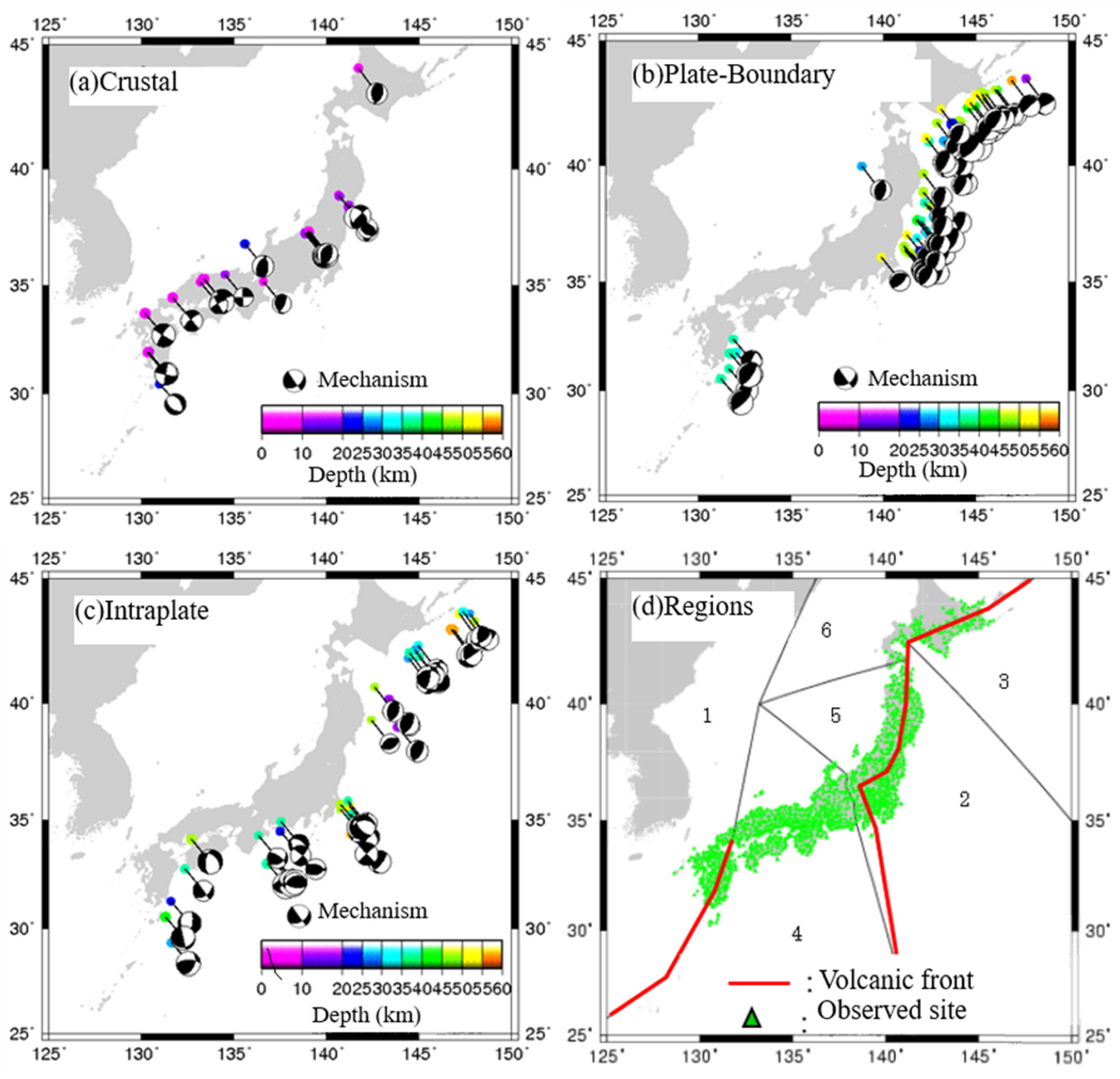

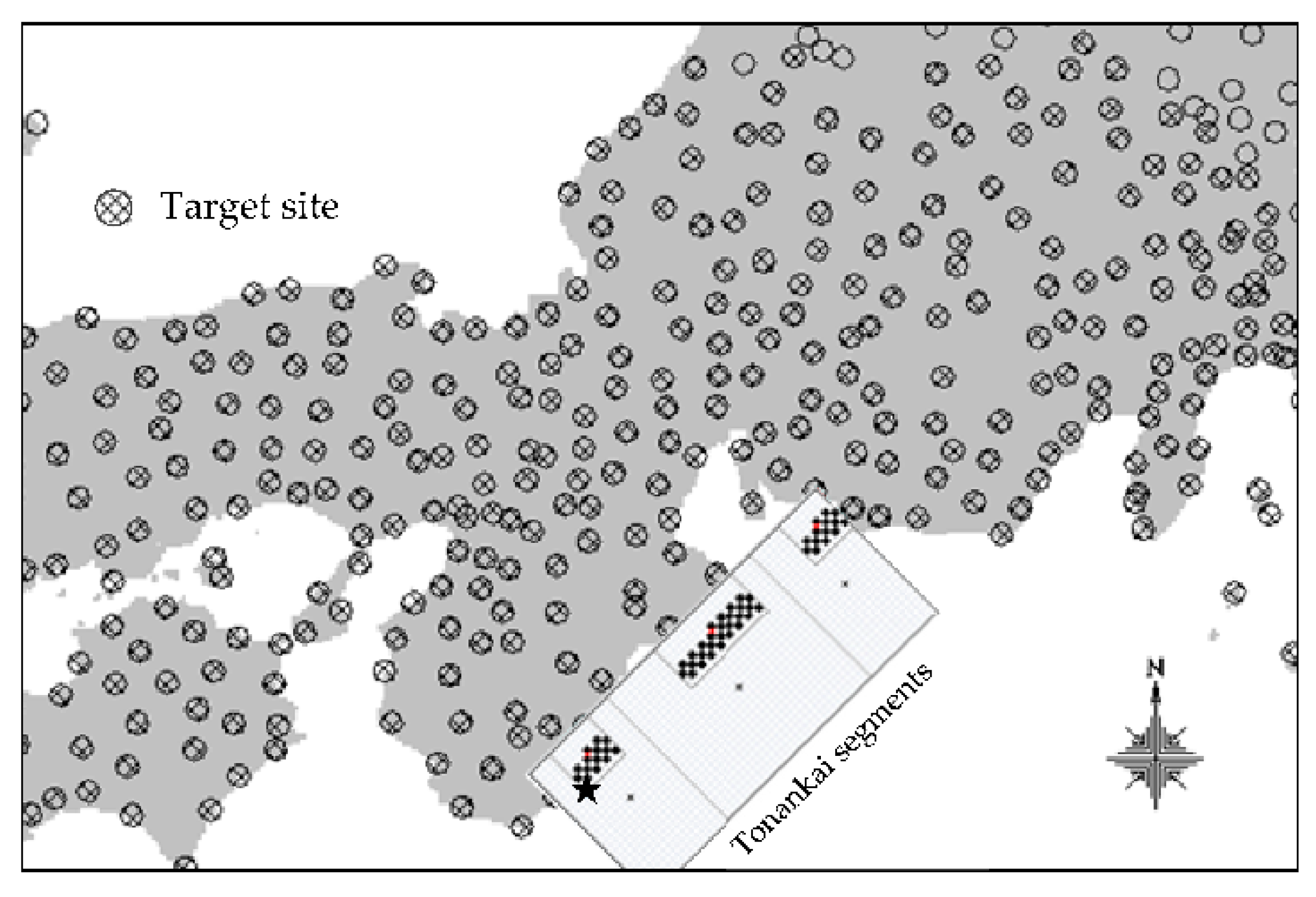
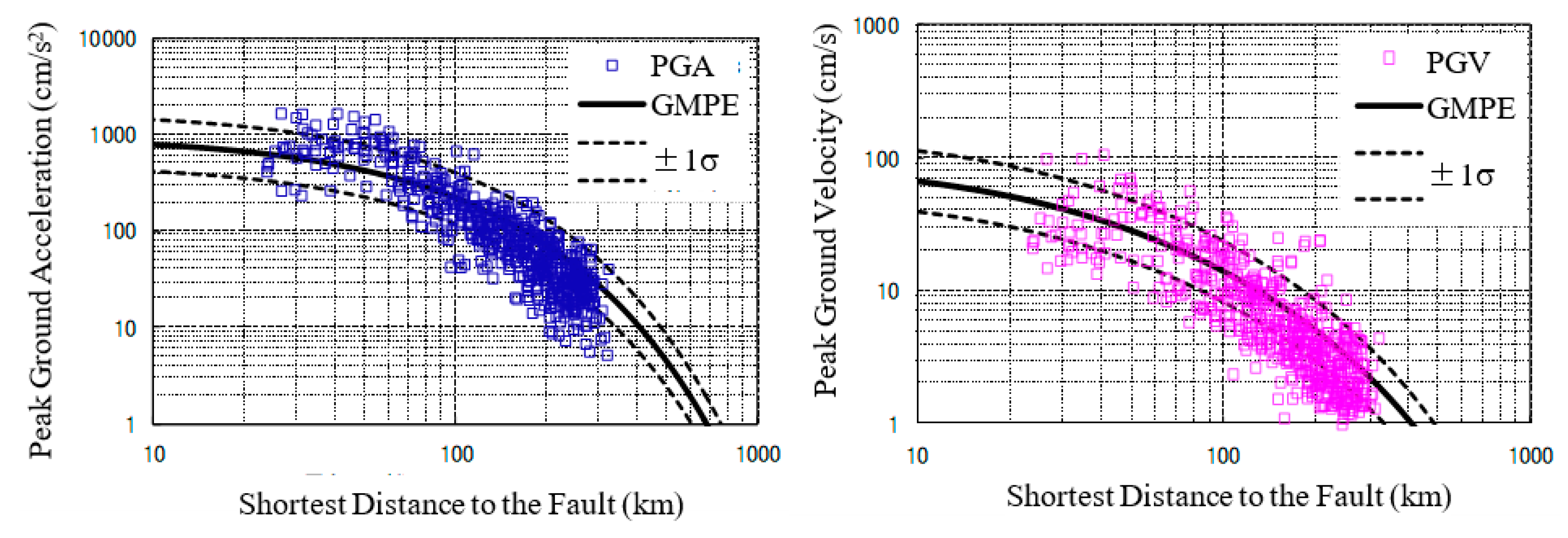
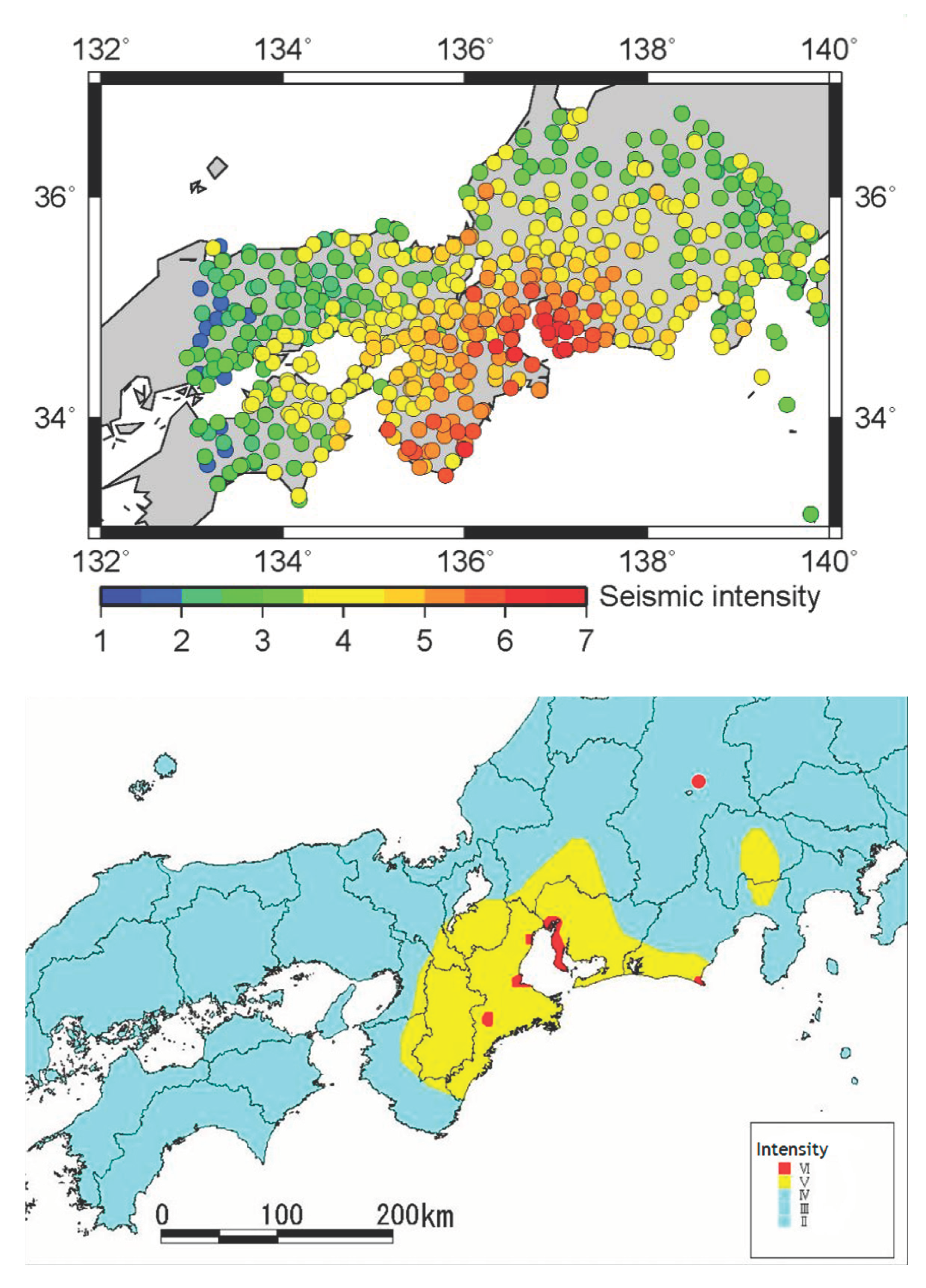
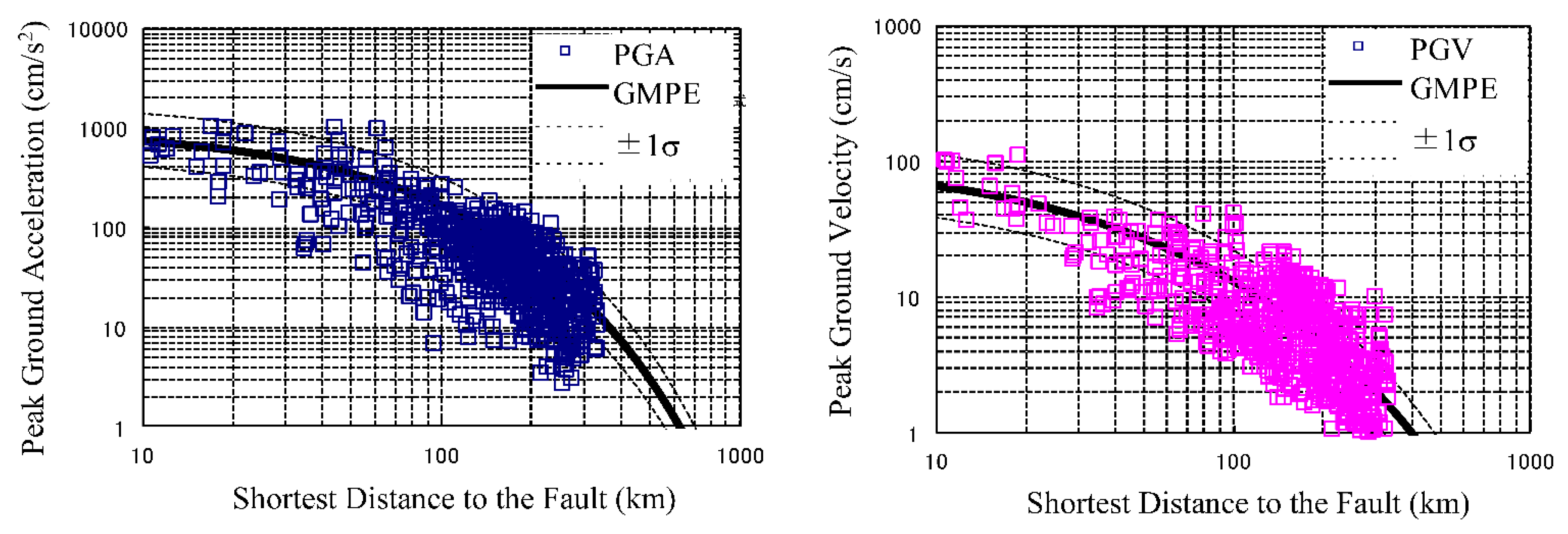
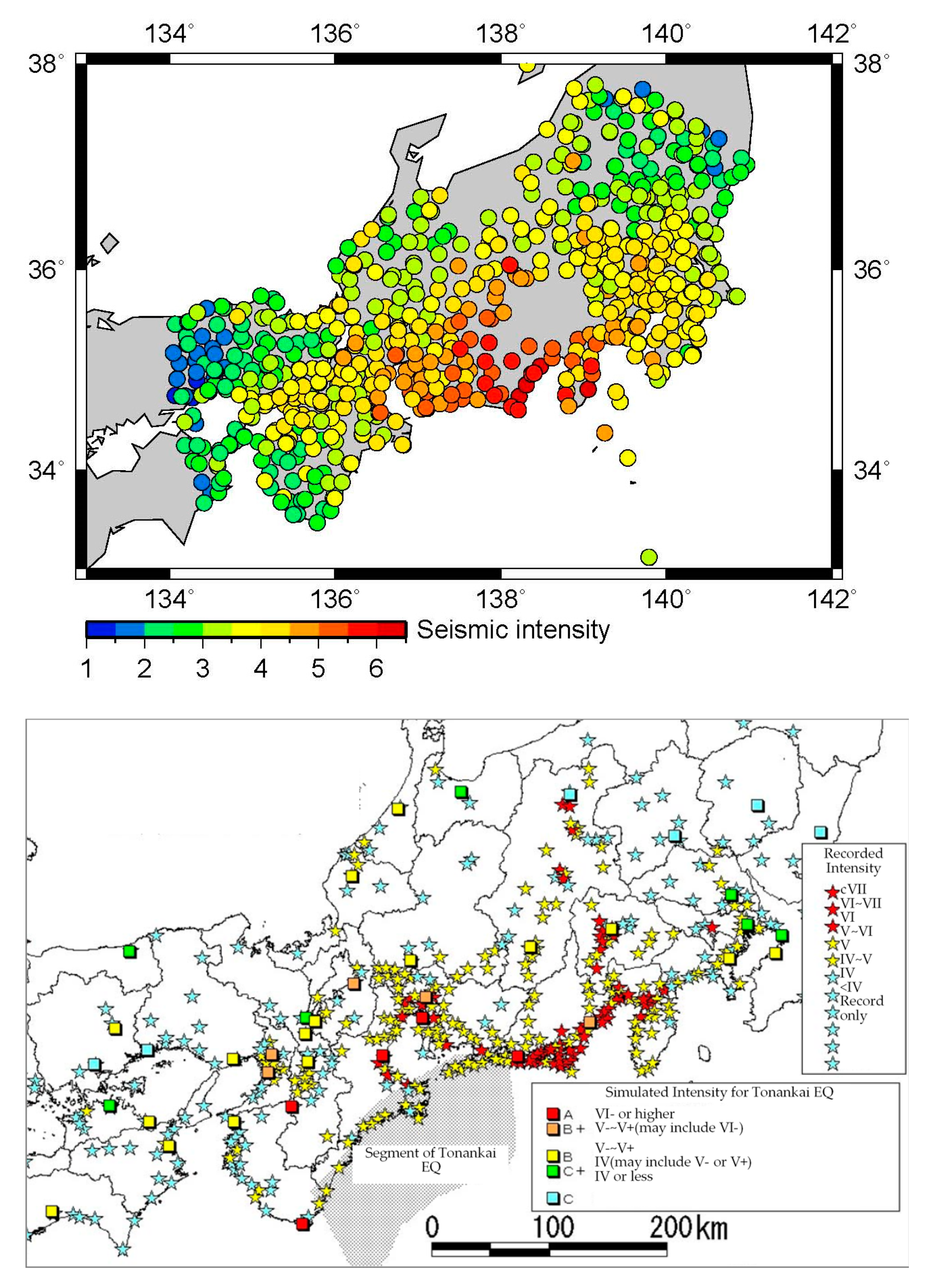
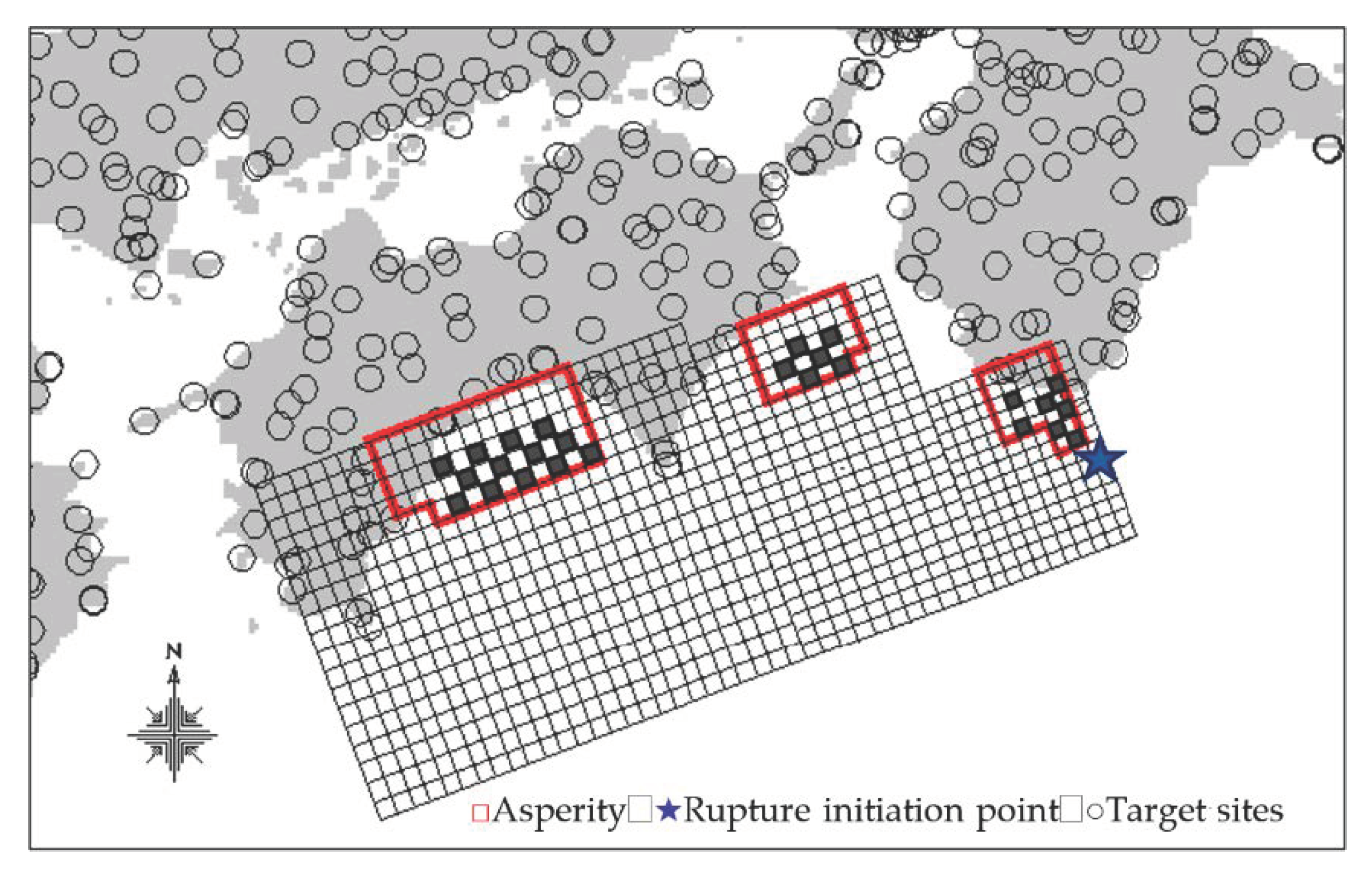

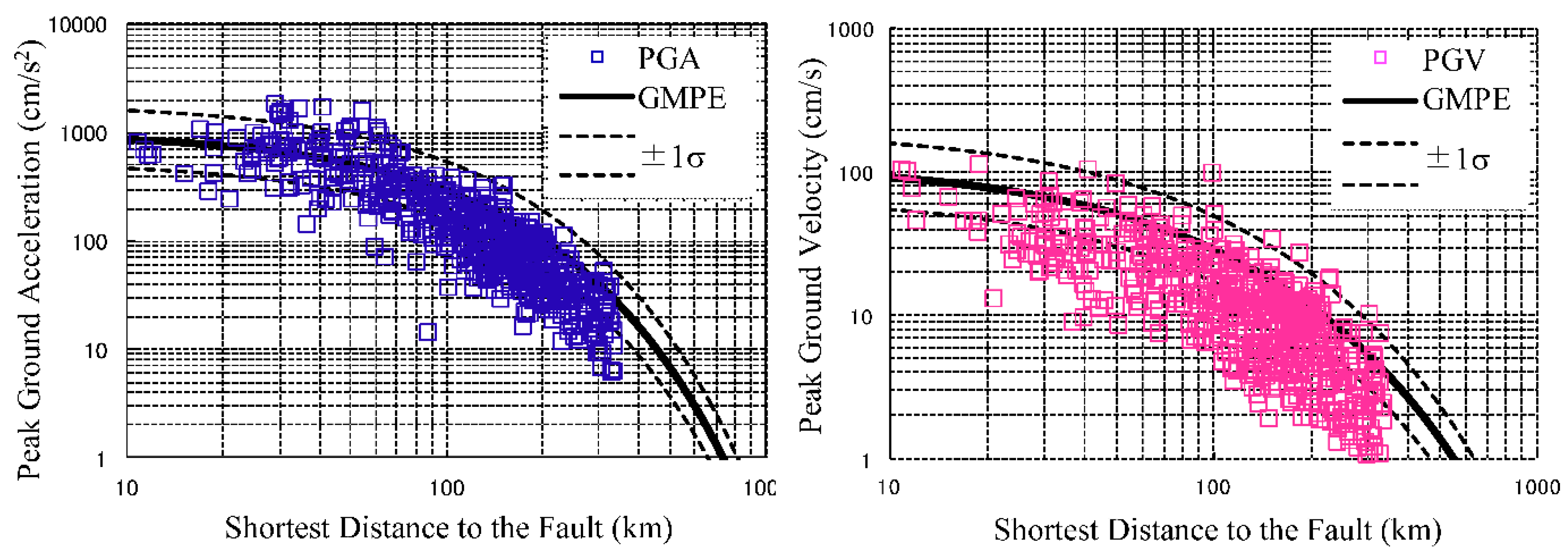
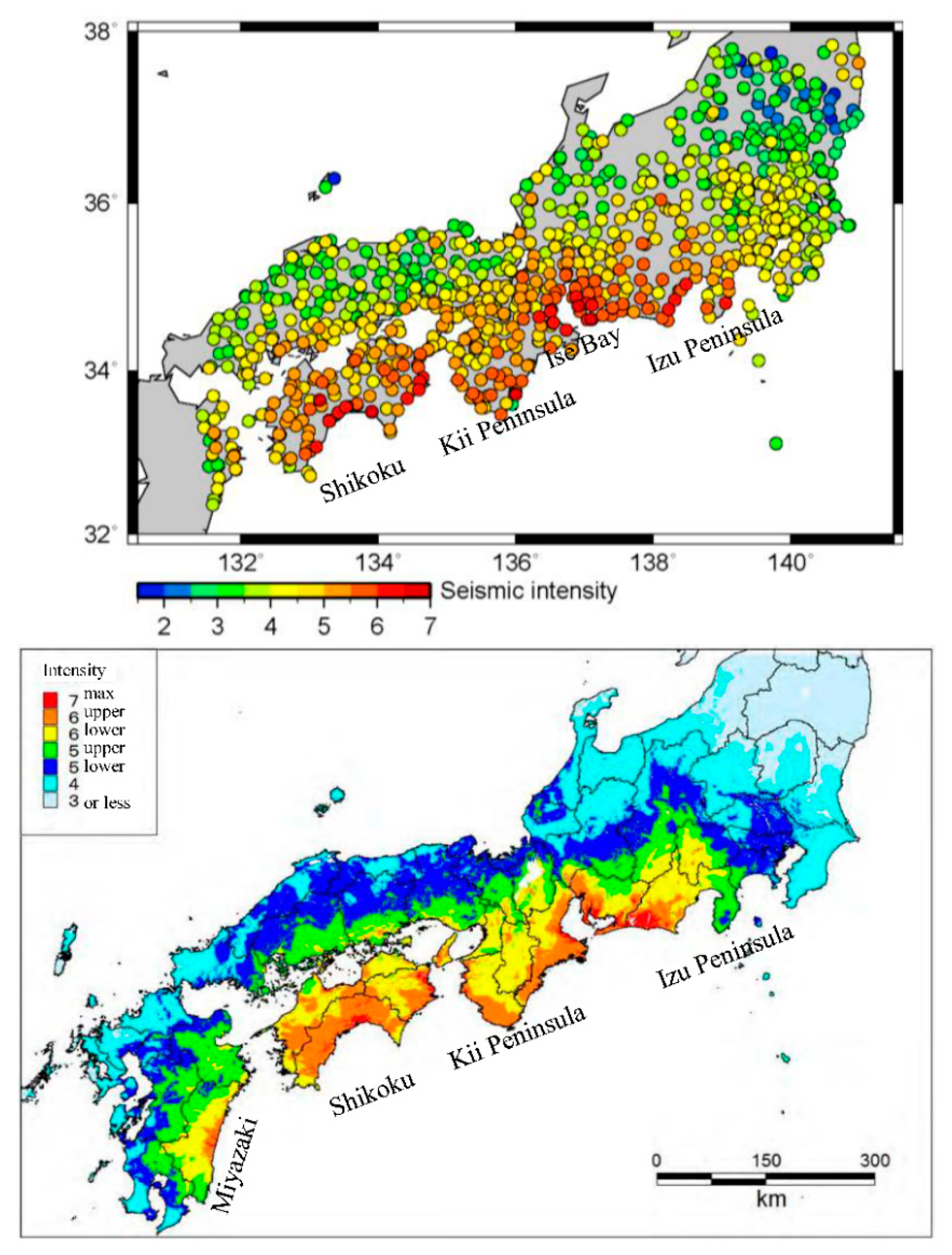


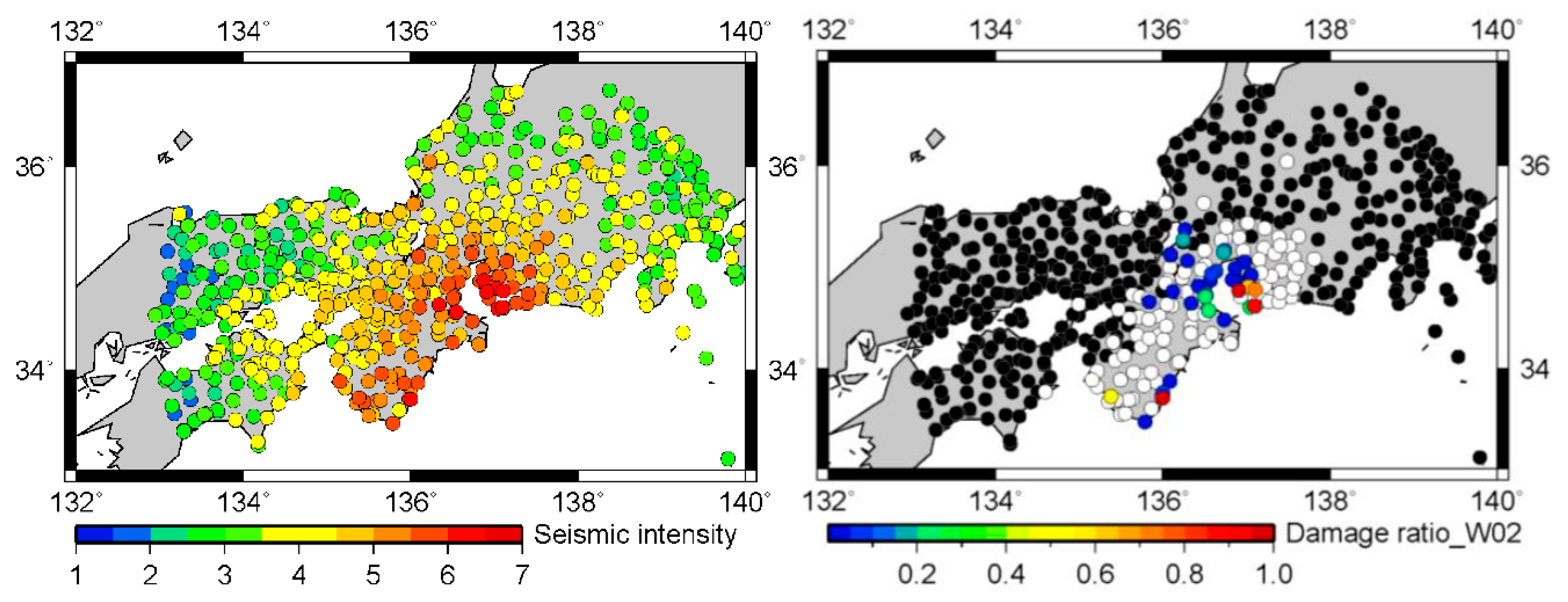
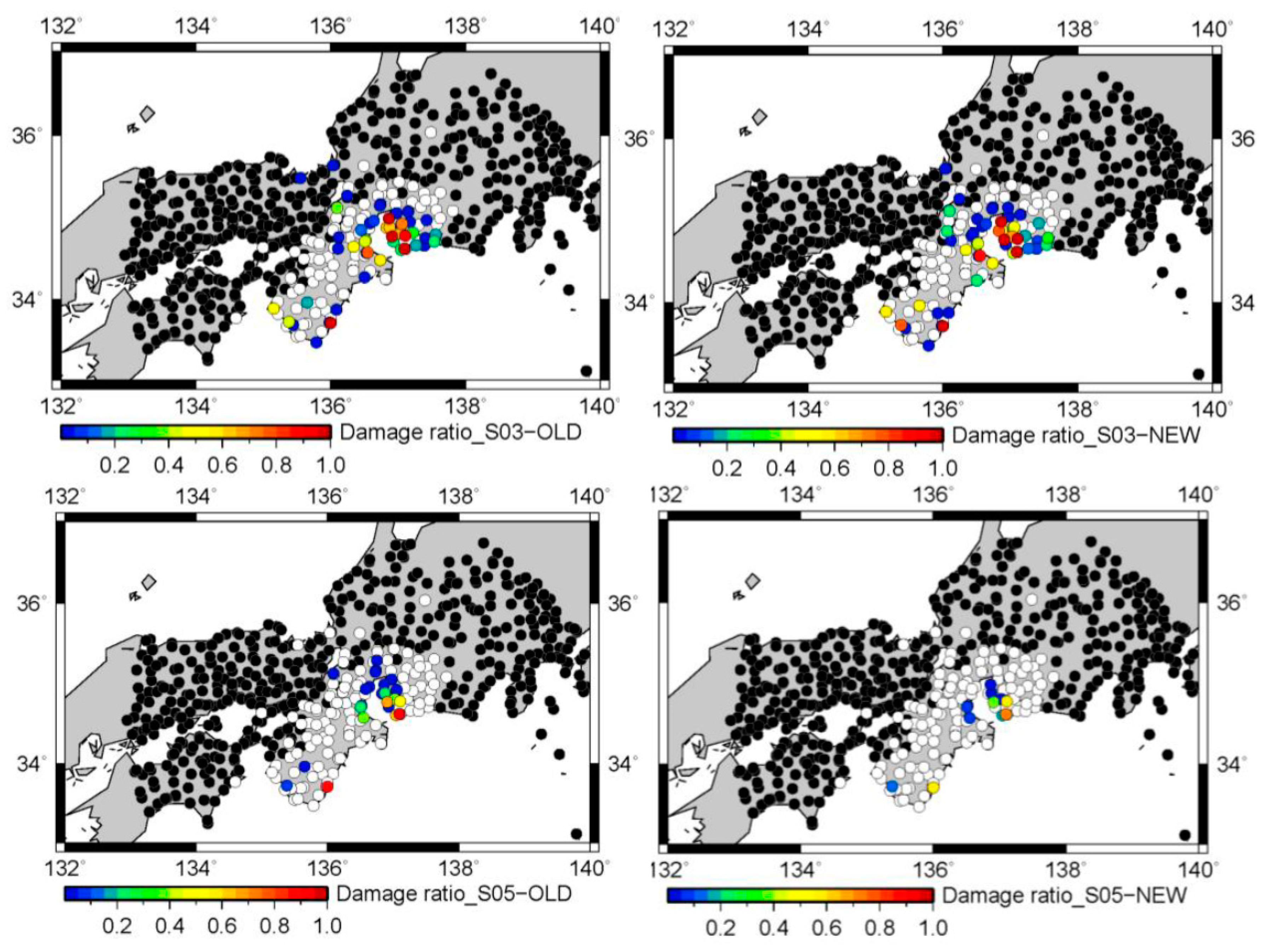

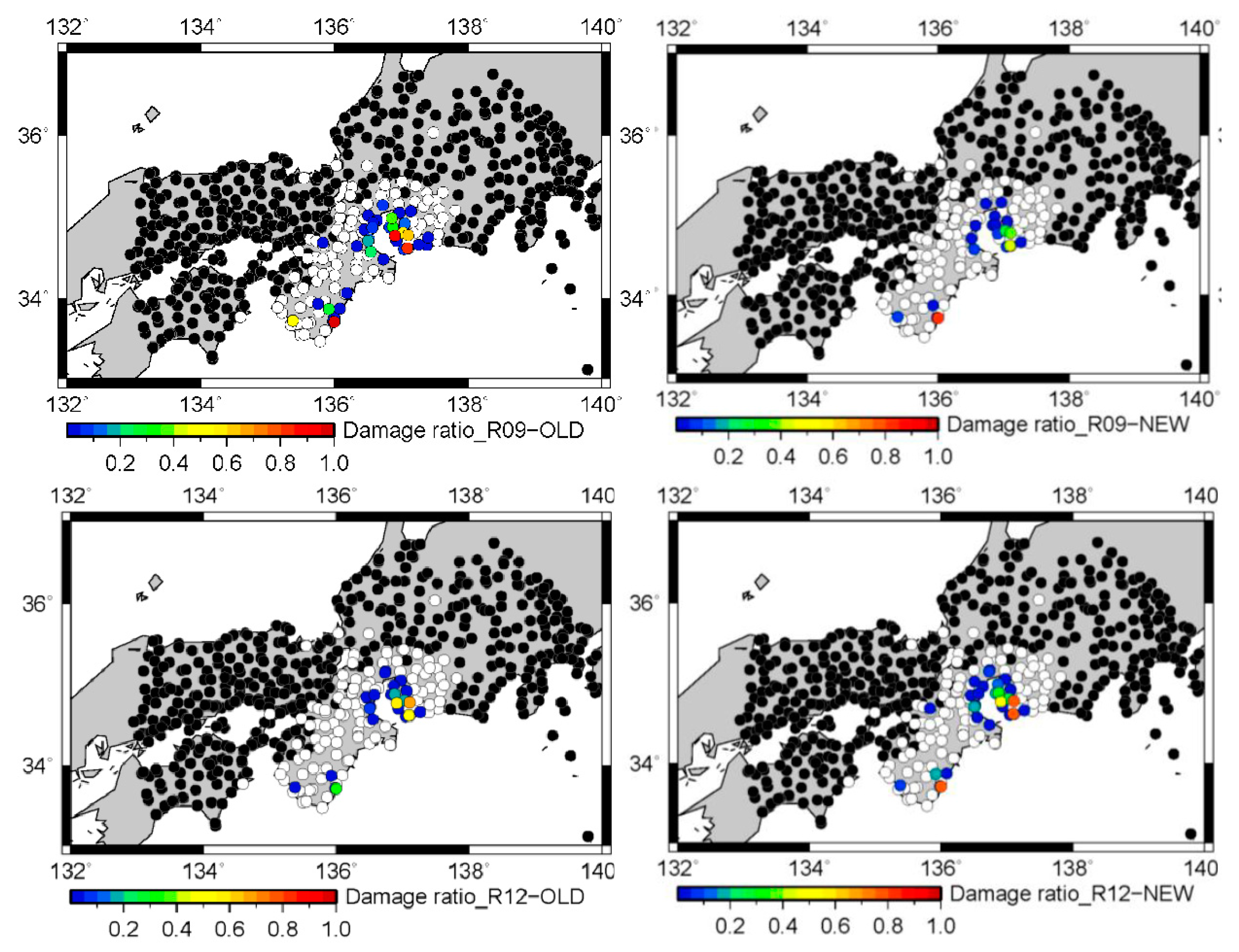
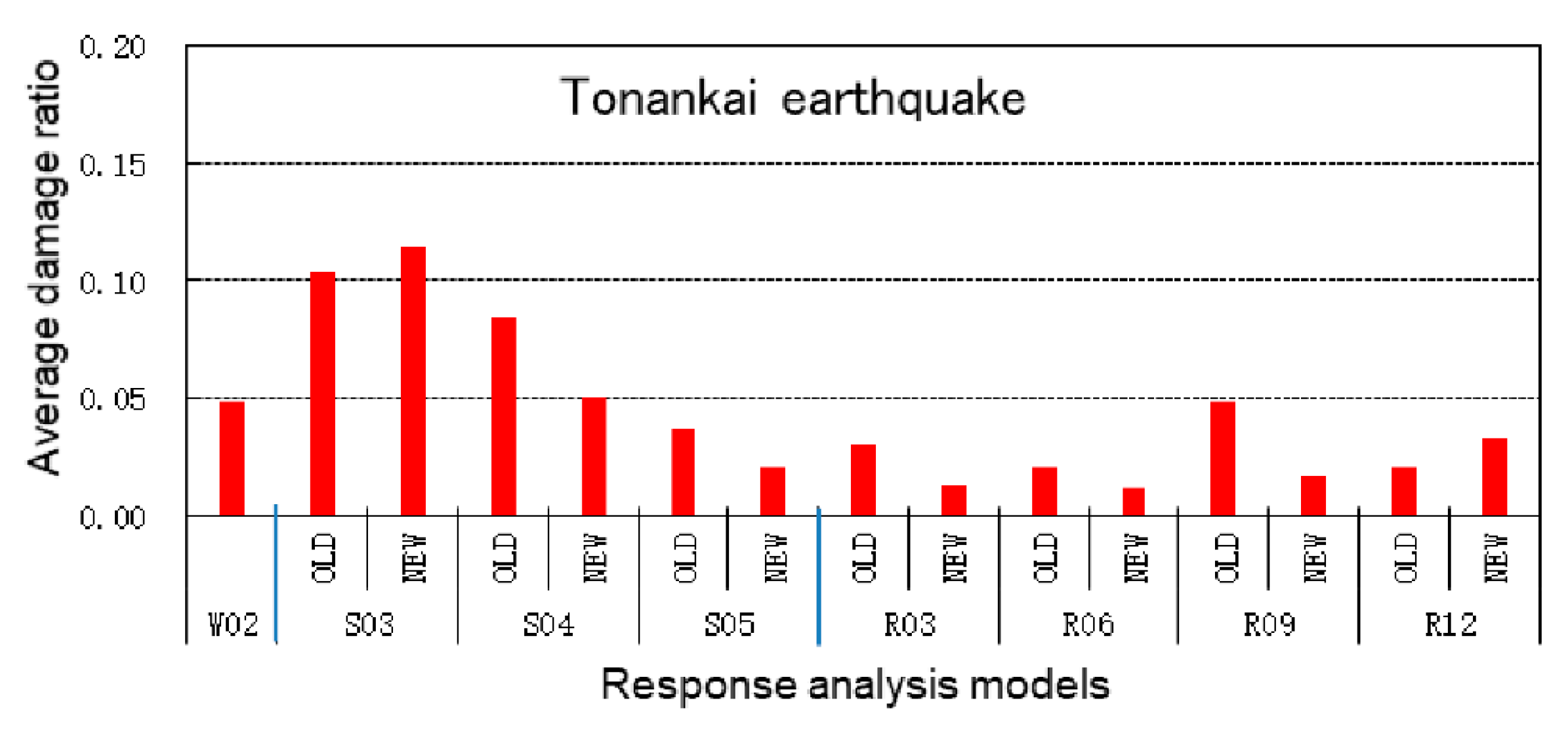


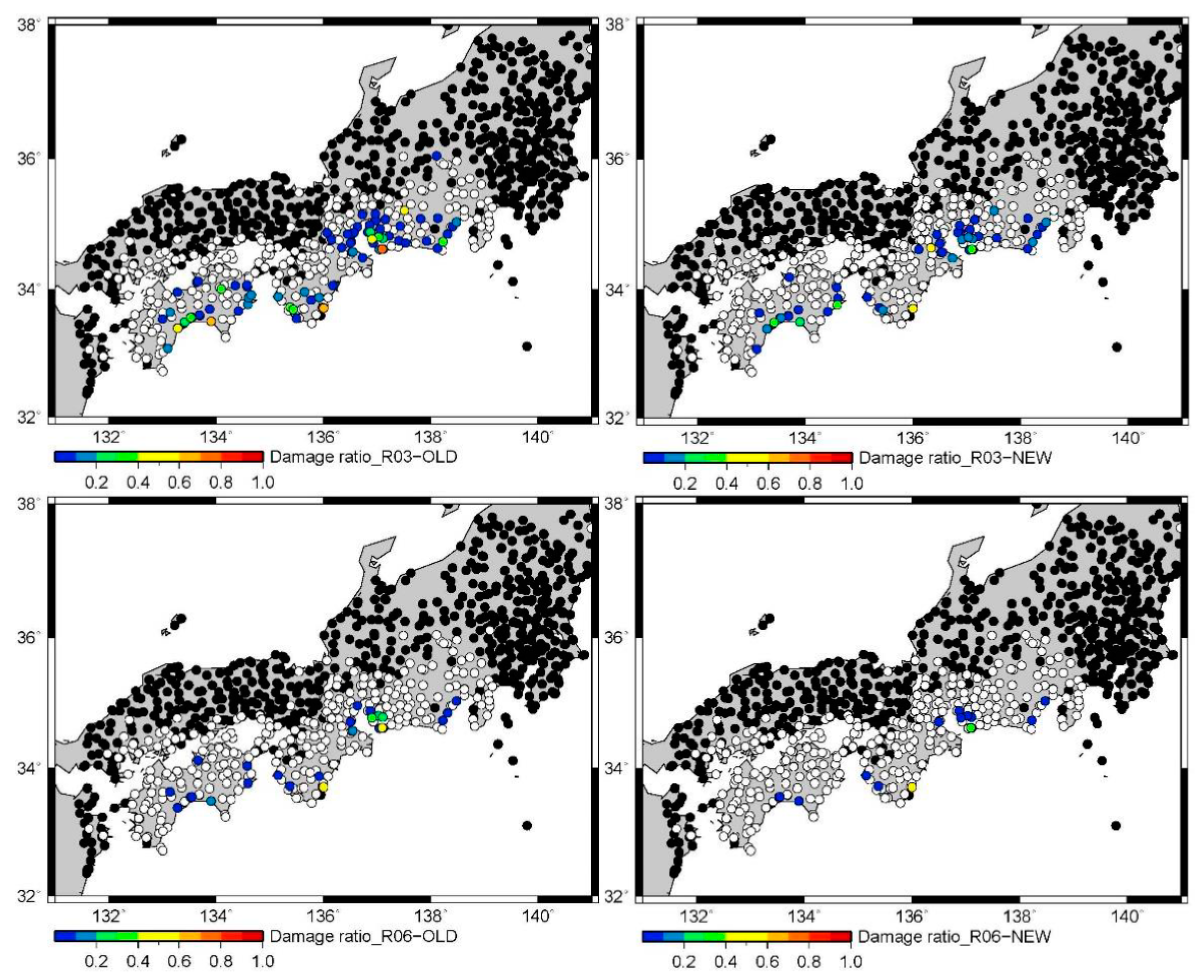
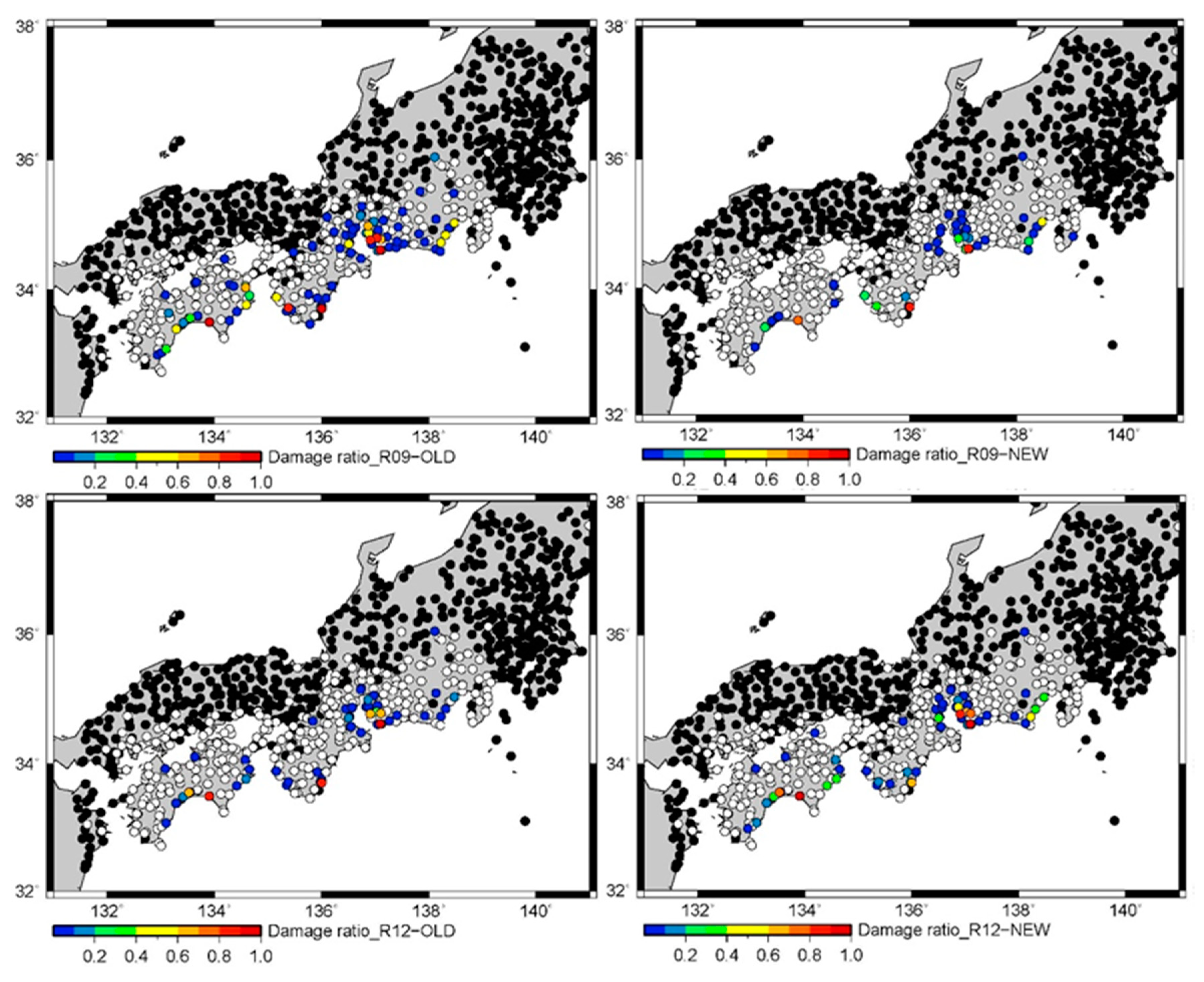
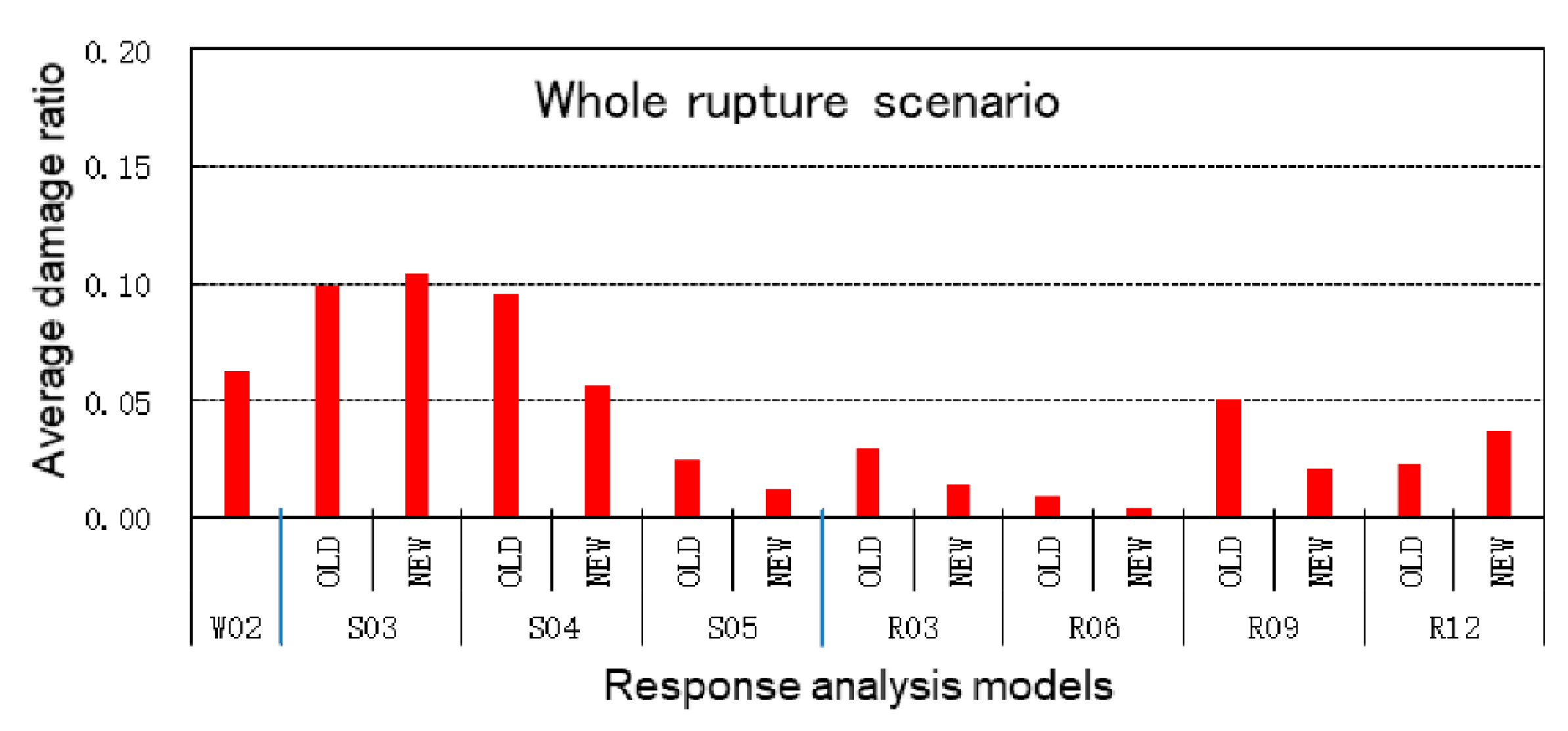
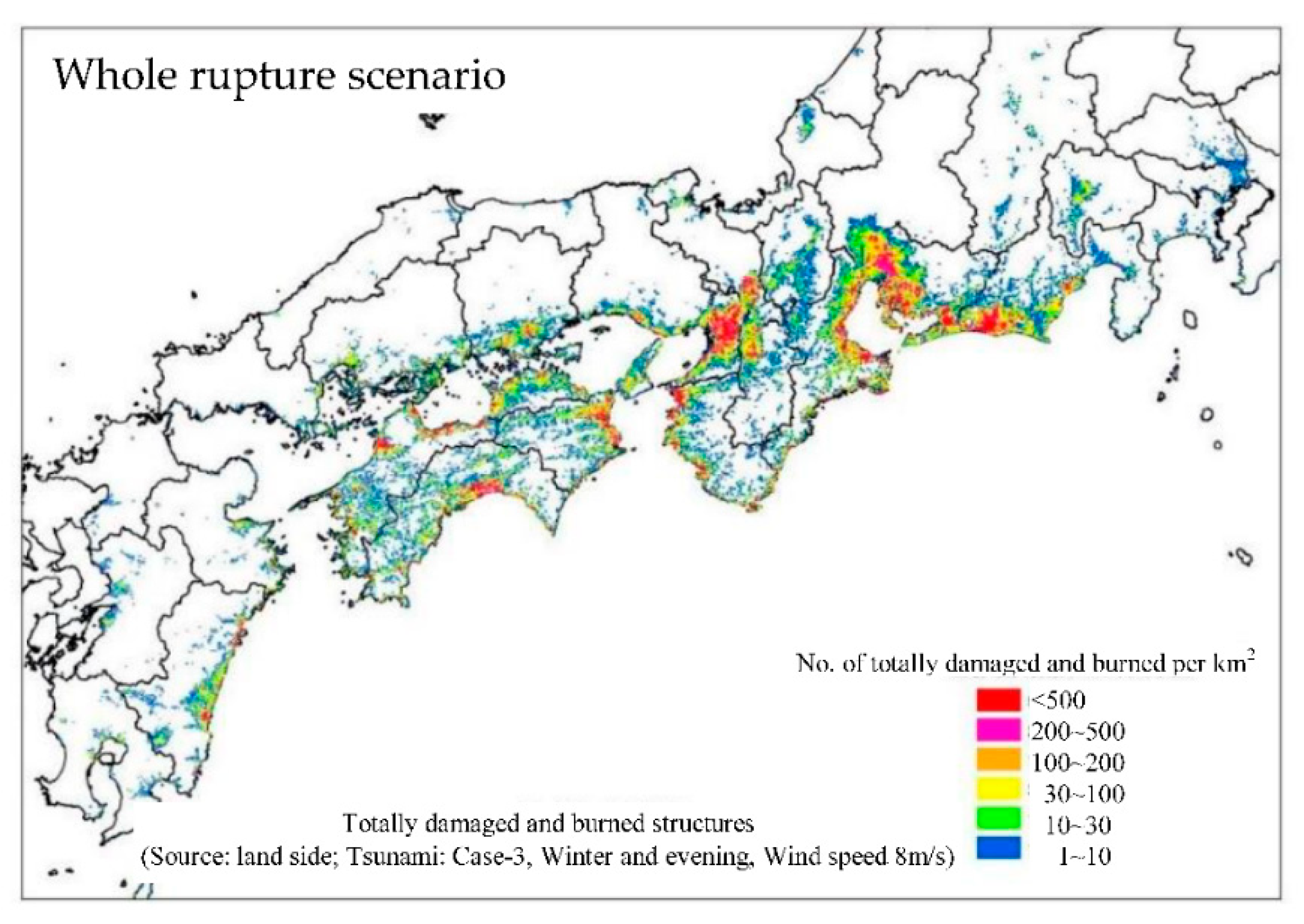
| Magnitude M | 8.1 |
| Total area (km2) | 14,040 |
| Seismic moment (N m) | 2.119 × 1021 |
| Average static stress drop (MPa) | 3.0 |
| Rupture speed (km/s) | 2.7 |
| Strike, dip, and rake (degree) | 250.7/14.0/122.7 |
| Slip in asperities (left/center/right, cm) | 601/850/601 |
| Slip in background (cm) | 299 |
Publisher’s Note: MDPI stays neutral with regard to jurisdictional claims in published maps and institutional affiliations. |
© 2021 by the authors. Licensee MDPI, Basel, Switzerland. This article is an open access article distributed under the terms and conditions of the Creative Commons Attribution (CC BY) license (https://creativecommons.org/licenses/by/4.0/).
Share and Cite
Baoyintu; Mandula, N.; Kawase, H. Broadband Strong-Motion Prediction for Future Nankai-Trough Earthquakes Using Statistical Green’s Function Method and Subsequent Building Damage Evaluation. Appl. Sci. 2021, 11, 7041. https://doi.org/10.3390/app11157041
Baoyintu, Mandula N, Kawase H. Broadband Strong-Motion Prediction for Future Nankai-Trough Earthquakes Using Statistical Green’s Function Method and Subsequent Building Damage Evaluation. Applied Sciences. 2021; 11(15):7041. https://doi.org/10.3390/app11157041
Chicago/Turabian StyleBaoyintu, Naren Mandula, and Hiroshi Kawase. 2021. "Broadband Strong-Motion Prediction for Future Nankai-Trough Earthquakes Using Statistical Green’s Function Method and Subsequent Building Damage Evaluation" Applied Sciences 11, no. 15: 7041. https://doi.org/10.3390/app11157041





